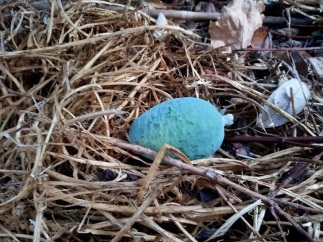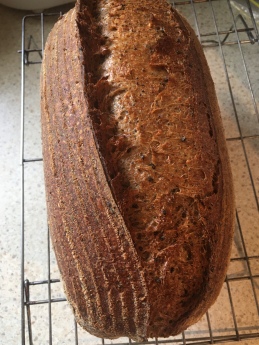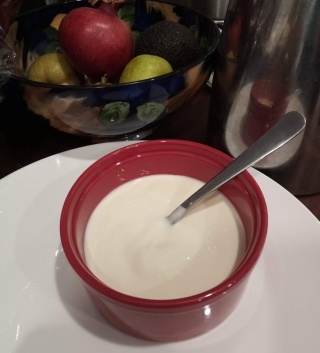Happy Easter, Adelaide.

NB: may not be an actual bunny egg.
It’s a strange one, I know, without camping and all the gatherings that usually go on, but maybe a time to reshape (not lose) some of the rituals that mark our seasons and cultures. And to do some reading! (more on this at the end).

We talked recently about zones, and I used this central permaculture concept as an analogy for how I was approaching care of home and community while physically distancing. Today the same zoning concept can apply to what we’re doing over Easter.
And, since we’ve all had our lives reshaped by a scary microbe, it seems timely to check in with some of the friendlier microbes in our lives.

Here in Zone 0 (the little house), we were treated to a Good Friday breakfast of home-made sourdough hot cross buns. Andrew (breadwinner, baker and chief miso-maker) whipped these up over the last 24 hours using this recipe. I could have stayed in bed all morning eating these with far too many cups of tea, but the sunshine called. We have been delighted to have Andrew grounded from his frequent work travel, milling grain to make fresh, sweet wholegrain flour and keeping us supplied with his beautiful bread (another favourite recipe here). Dried sourdough starter (known fondly here as ‘Emma’ in honour of she who shared it with us) has even been posted interstate to friends starting their own baking.
 My present contribution to the family ferments mostly consists of yogurt. Like the bread, good yogurt made at home is delicious, a fraction of the price of the bought product, and of course you know exactly what has gone into it. Mine is made with fresh organic milk, a dash of cream and a spoonful of milk powder to thicken it, plus a tablespoon of the previous batch and/or of a good quality bought yogurt that we’ve recently enjoyed (e.g. Paris Creek or Jalna). For ‘dessert’ batches I also add a few drops of vanilla extract and stevia liquid.
My present contribution to the family ferments mostly consists of yogurt. Like the bread, good yogurt made at home is delicious, a fraction of the price of the bought product, and of course you know exactly what has gone into it. Mine is made with fresh organic milk, a dash of cream and a spoonful of milk powder to thicken it, plus a tablespoon of the previous batch and/or of a good quality bought yogurt that we’ve recently enjoyed (e.g. Paris Creek or Jalna). For ‘dessert’ batches I also add a few drops of vanilla extract and stevia liquid.
I heat the milk to about 80C on the stove, keep it hot for a few minutes, adding the extras towards the end, and then cool it rapidly in a water bath to about 40C before stirring in the starter portion of yogurt. It cultures and sets overnight in an old EasiYo insulated pot (though a stockpot full of towels with a hot water bottle would be fine too). I used to go more by feel than by temperature but have found that this method, plus leaving it strictly undisturbed for at least 6 hours, gives me much more consistent results.
Yogurt is our quickest ferment, but at the other end of the spectrum is miso, made over the course of a year and kept in the shed (Zone 1 – yes, it’s that resilient!) to slowly develop its rich, complex, intoxicating umami flavour. We awakened to the possibility of making our own miso when we visited Japan in 2017 and stayed in an extraordinary guesthouse in the countryside, where we were instructed in soba noodle making and then enjoyed our noodles in a soup that included our hosts’ home-made miso.
Miso takes a little more organising to get started, but goes on rewarding you for such a long time that it’s worth making a project of it. Here’s the recipe Andrew uses, and the koji rice is available by post from Little Tokyo in Adelaide. Andrew writes:
- 1kg dried organic soybeans
- 900g koji rice
- 400g sea salt
- 2tsp miso paste mixed in water
Also in Zone 1 – but hopefully with a lot less fermentation – we’ll be sowing a fresh batch of seeds into punnets this long weekend. There was a lot of direct seeding five days ago (scroll down in that post for What to Plant Now) and many of these have now germinated – it just remains to be seen how very very many of those seedlings turn out to be the silverbeet and rainbow chard that had already self-seeded there! They are great, but diversity is what we’re after.
In Zone 2, we’ll thank the chooks for being our Easter bunnies by reliably delivering the eggs and we’ll hoist the tomatoes a bit further up the chook house to catch some sun. In Zone 3, we’ll find fallen feijoas (which Mum always calls the green Easter eggs) and we’ll start rescuing persimmons from the lorikeets – the cheeky devils have started gnawing their way through the netting sleeves to the fruit now, but it’s mostly ripe enough to come inside and finish sweetening on the bench.
Zones 4 and 5 are the places that many of us would traditionally visit at Easter – national parks, forests, beaches and camping places. For the purposes of this hibernation time, I’ll count the streetscape as our zone 4 and turn my attention to challenging the imminent removal of a nearby tree that is sorely needed right where it is, for its role in summer cooling and winter flood mitigation, not to mention its current and future role in providing native habitat.
And the same principle extends to Zone 5. Have you heard of a forest area that faces imminent logging? Perhaps one that protects water catchments for city reservoirs? Perhaps a patch that has been damaged by bushfires and now loses its chance to regenerate? Perhaps an unburnt forest where animals have fled for survival after losing their nearby habitat in those fires? Since you can’t go camping in the forest this Easter, how about finding and sharing such stories and petitions, and doing what you can remotely to protect those precious places? So that hopefully, in an Easter to come, we can explore them and be healed in their presence again.
I have rambled long enough, but when you are ready for some more reading, do grab the free and printable Starting a Garden in Adelaide PDF book. In fact, why not print a copy for a new gardener in your neighbourhood and drop it in their letterbox as an Easter gift?
And for a far more comprehensive permaculture guide to surviving and creatively thriving in such topsy-turvy times as these, you can’t go past David Holmgren’s RetroSuburbia – now available online on a pay-what-you-feel basis as well as the original, colourful, holdable, printed-in-Australia hard copy.
